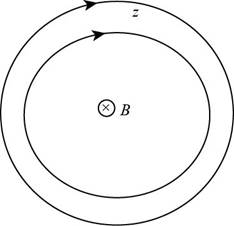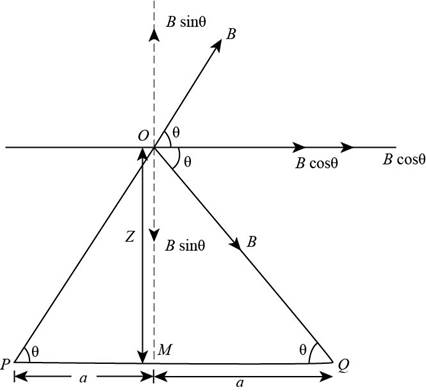
Concept explainers
(a)
To draw: The magnetic field pattern in the
(a)
Answer to Problem 30.72CP
The magnetic field pattern in the

Figure (1)
Explanation of Solution
Given info: The amount of current flow in infinitely long wire is
The magnetic field pattern in the

Figure (1)
From the right hand thumb rule, when the thumb is directed towards the direction of current, the curled fingers show the direction of magnetic field.
(b)
The value of magnetic field at origin.
(b)
Answer to Problem 30.72CP
The value of magnetic field at origin is
Explanation of Solution
Given info: The amount of current flow in infinitely long wire is
The direction of magnetic field due to current carry wire is shown below.

Figure (2)
Write the expression for the magnetic field due to current carrying wire.
Here,
From the given figure,
Substitute
The magnetic field component
The resultant magnetic field along
Substitute
From the figure (2),
Substitute
Conclusion:
Therefore, the value of magnetic field at origin is
(c)
The value of magnetic field at
(c)
Answer to Problem 30.72CP
The value of magnetic field at
Explanation of Solution
Given info: The amount of current flow in infinitely long wire is
From the equation (3), the expression for magnetic field is,
The value of magnetic field at
Conclusion:
Therefore, the value of magnetic field at
(d)
The magnetic field at points along the
(d)
Answer to Problem 30.72CP
The magnetic field at points along the
Explanation of Solution
Given info: The amount of current flow in infinitely long wire is
From the calculated value in part (b), the magnetic field at points along the
Conclusion:
Therefore, the magnetic field at points along the
(e)
The distance along the positive
(e)
Answer to Problem 30.72CP
The magnetic field is maximum at
Explanation of Solution
Given info: The amount of current flow in infinitely long wire is
From the calculated value in part (b), the magnetic field at points along the
For maximum value of
Substitute
Substitute
Conclusion:
Therefore, the magnetic field is maximum at
(f)
The maximum value of magnetic field.
(f)
Explanation of Solution
Given info: The amount of current flow in infinitely long wire is
From the calculated value in part (b), the magnetic field at points along the
Substitute
Substitute
Simplify further,
Conclusion:
Therefore, the maximum value of magnetic field is
Want to see more full solutions like this?
Chapter 30 Solutions
EBK PHYSICS FOR SCIENTISTS AND ENGINEER
- Hi! I need help with these calculations for part i and part k for a physics Diffraction Lab. We used a slit width 0.4 mm to measure our pattern.arrow_forwardExamine the data and % error values in Data Table 3 where the angular displacement of the simple pendulum decreased but the mass of the pendulum bob and the length of the pendulum remained constant. Describe whether or not your data shows that the period of the pendulum depends on the angular displacement of the pendulum bob, to within a reasonable percent error.arrow_forwardIn addition to the anyalysis of the graph, show mathematically that the slope of that line is 2π/√g . Using the slope of your line calculate the value of g and compare it to 9.8.arrow_forward
- An object is placed 24.1 cm to the left of a diverging lens (f = -6.51 cm). A concave mirror (f= 14.8 cm) is placed 30.2 cm to the right of the lens to form an image of the first image formed by the lens. Find the final image distance, measured relative to the mirror. (b) Is the final image real or virtual? (c) Is the final image upright or inverted with respect to the original object?arrow_forwardConcept Simulation 26.4 provides the option of exploring the ray diagram that applies to this problem. The distance between an object and its image formed by a diverging lens is 5.90 cm. The focal length of the lens is -2.60 cm. Find (a) the image distance and (b) the object distance.arrow_forwardPls help ASAParrow_forward
 Physics for Scientists and Engineers: Foundations...PhysicsISBN:9781133939146Author:Katz, Debora M.Publisher:Cengage Learning
Physics for Scientists and Engineers: Foundations...PhysicsISBN:9781133939146Author:Katz, Debora M.Publisher:Cengage Learning Principles of Physics: A Calculus-Based TextPhysicsISBN:9781133104261Author:Raymond A. Serway, John W. JewettPublisher:Cengage Learning
Principles of Physics: A Calculus-Based TextPhysicsISBN:9781133104261Author:Raymond A. Serway, John W. JewettPublisher:Cengage Learning Physics for Scientists and Engineers with Modern ...PhysicsISBN:9781337553292Author:Raymond A. Serway, John W. JewettPublisher:Cengage Learning
Physics for Scientists and Engineers with Modern ...PhysicsISBN:9781337553292Author:Raymond A. Serway, John W. JewettPublisher:Cengage Learning Physics for Scientists and EngineersPhysicsISBN:9781337553278Author:Raymond A. Serway, John W. JewettPublisher:Cengage Learning
Physics for Scientists and EngineersPhysicsISBN:9781337553278Author:Raymond A. Serway, John W. JewettPublisher:Cengage Learning
 Physics for Scientists and Engineers, Technology ...PhysicsISBN:9781305116399Author:Raymond A. Serway, John W. JewettPublisher:Cengage Learning
Physics for Scientists and Engineers, Technology ...PhysicsISBN:9781305116399Author:Raymond A. Serway, John W. JewettPublisher:Cengage Learning





